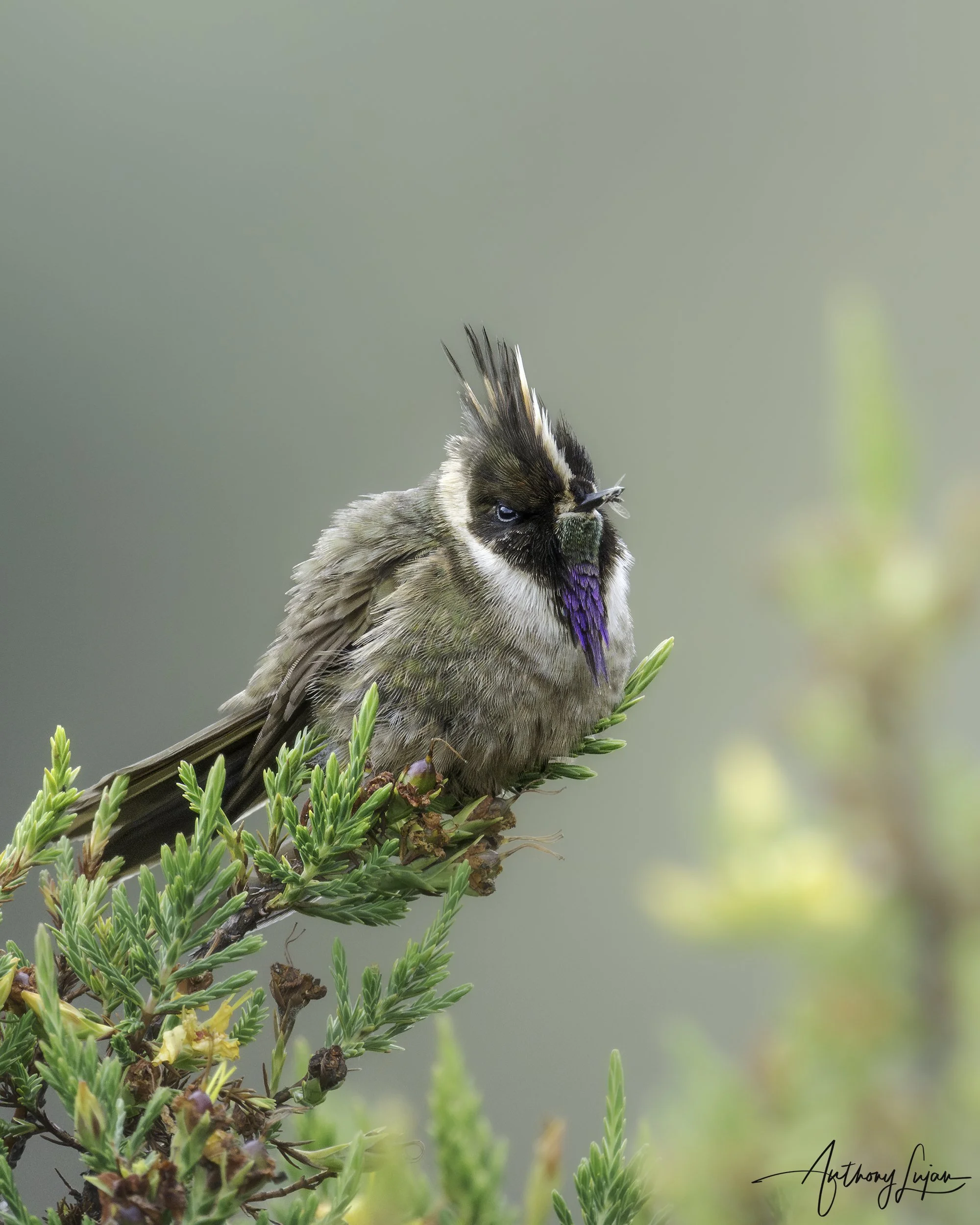How I Photographed the Buffy Helmetcrest
Sony A1, Sony 600mm, Sony 2x teleconverter
f/9, 1/800, ISO 800
Once you’ve seen an Oxypogon, your life is forever changed! It's safe to say that if you've seen or photographed one, you’ll want to see all of the four species. These captivating hummingbirds have a way of stealing hearts and igniting passions in bird enthusiasts and photographers alike.
The Majestic Buffy Helmetcrest
The Buffy Helmetcrest (Oxypogon stuebelii) was the first helmetcrest species I photographed, and I instantly fell in love. These larger, short-billed hummingbirds live at extremely high altitudes in Colombia's central Andes; this particular individual lives on an active volcano. With a white-buffy and black spiky crest and an impressive green and purple beard, the Buffy Helmetcrest is a magnificent sight to behold and a joy to photograph.
My Guide, Robin Mettler: A Partner in Adventure
For the past few years, Robin Mettler has been my dedicated guide in Colombia. While discussing my next set of targets he was planning in Manizales, Robin mentioned we would be near the Oxypogon. We have quite the backstory, having trekked together to see the Blue-bearded Helmetcrest (Oxypogon cyanolaemus). That two-day journey, climbing steep mountain terrain (with me on a mule for part of the way), was unforgettable. So, the phrase "Oxypogon" carries a lot of excitement for us. It brings back memories of rare hummingbird sightings and our enthusiastic, whispered shouts: "Oxypogon, Anthony! Oxypogon here… there… Robin, Oxypogon, look!" Sorry, I easily get distracted by memories and BIRDS!
Yep, that’s me in the bush with my 600mm. Actually, I’m standing in a marsh and still smiling as the Buffy Helmetcrest is perched in front of us!
Capturing the Buffy Helmetcrest: A Thrilling Encounter
In 2022, I successfully photographed the stunning Buffy Helmetcrest, but this time my goal was to elevate my work even further with the invaluable guidance of Robin, combined with my upgraded photography gear. Additionally, my friend Terry, a fellow photographer with whom I traveled to Cuba in pursuit of the captivating Bee Hummingbird—the smallest bird in the world—has never had the opportunity to visit Colombia and is excitedly joining us on this trip. This adventure promises to unveil new species while also allowing us to encounter many familiar favorites. One standout species for Terry is the helmetcrest, so it was essential to include it in our carefully planned itinerary, dedicating a single day specifically for capturing its beauty through our lenses.
Below are some of my hummingbird photography from 2022.
As we arrived, the light was starting to look good. The helmetcrest perched nicely before us, albeit backlit. The fog was light, and mist was in the air. The male chirped, moving around, changing sides, flying off, and changing perches. While photographing and taking video, we noted where he perched and how often he flew off.
Observing and Photographing Unique Behaviors
We spent quality time with this individual, watching his movements, preening, behaviors, and patterns. His curiosity about us was evident; at times, he approached as if to check us out. Not in a confrontational way, but more like a curious nature. Several of my photos show him looking directly into my camera.
Sony A1, Sony 600mm, Sony 2x teleconverter
f/8, 1/320, ISO 5000
I always aim to capture something unique or different while photographing hummingbirds – emotion, movement, or personality. I strive for shots with beaks open, expressions, tongues sticking out, or even eyes closed.
Here are a few unique photos of the Buffy Helmetcrest, including one with a bug in its beak, a shot I haven't seen before anywhere else. I also love photographing hummingbirds perfectly, imperfect! Like the straightforward look with his crest “crown looking” tilting to the left normally they look like diamond or mohawks. Or the open, wide mouth eyes closed. I haven’t seen a helmetcrest photograph like this. I find it unique and creative and yet expressive on his part, not mine.
The Value of a Great Guide
Working with guides like Robin is invaluable. He's not focused on his photography like other guides, but he's focused on yours, ensuring you get the shots you’re proud of. He's there to make you happy and will offer suggestions or tips to get you there. The Buffy Helmetcrest is in a protected territory, so Robin couldn't do his normal “Robininizing perch setups” or place feeders closer. Helmetcrests are not feeder hummingbirds. They only feed on flowers and insects.
While I focused on the hummingbird, shooting frames, Robin also watched its behavior. Often, we would simultaneously say, "He's going to stretch; be ready!" His guidance in the field was crucial, as understanding the bird's behavior helped me focus and prepare for the shot.
A Second Chance for More Magic
We hadn’t planned a second visit, satisfied with our initial success. But, who can resist more videos and photos of the helmetcrest? We decided to go again. This time, I got a little closer, capturing better videos and photographs without the teleconverter.
Trusting your guide and seizing second opportunities is always a good idea. How often will you be in that same region again? So why not take every chance you get!
Conclusion
Photographing the Buffy Helmetcrest with Terry and Robin was an unforgettable experience, full of excitement and wonder. Seeing Terry’s expression as he photographed his first Oxypogon is something I celebrate. Every trip to see different hummingbird species is a new adventure, filled with unique moments and breathtaking sights. If you ever can witness an Oxypogon, take it – you’ll cherish the memories forever.
The Park Ranger was really friendly. I greet everyone with a smile and hello. This opens up conversations and builds friendships. He asked for our photos, and we asked for his. It was a great way to say goodbye to the Buffy Helmetcrest. Until next time!
Robin has recently found new locations for the Buffy and Green-bearded Helmetcrest. Be sure to contact him using the link below. His Instagram account is also included in the link. He will be posting some absolutely amazing photos from the new locations, which is mind-blowing!
Visit Robin Mettler’s guide page on my website.
Please note: The content provided here reflects Anthony’s personal experience as a dedicated photographer and details the specific methods he has utilized to successfully photograph this particular hummingbird species. It is important to understand that many complex factors are at play in the world of photography, and therefore not everyone may have the same experiences or outcomes as Anthony. Individual circumstances, varying levels of expertise, camera gear, and distinct approaches can all significantly influence the final results.












